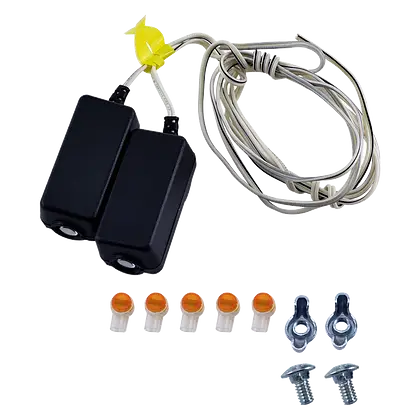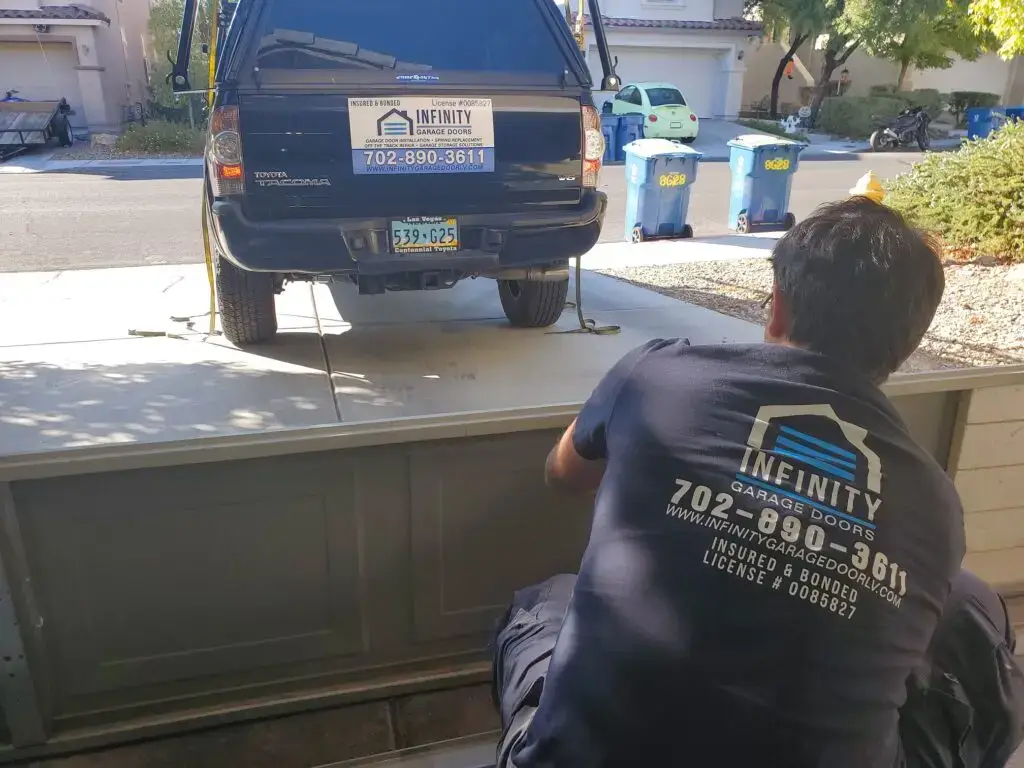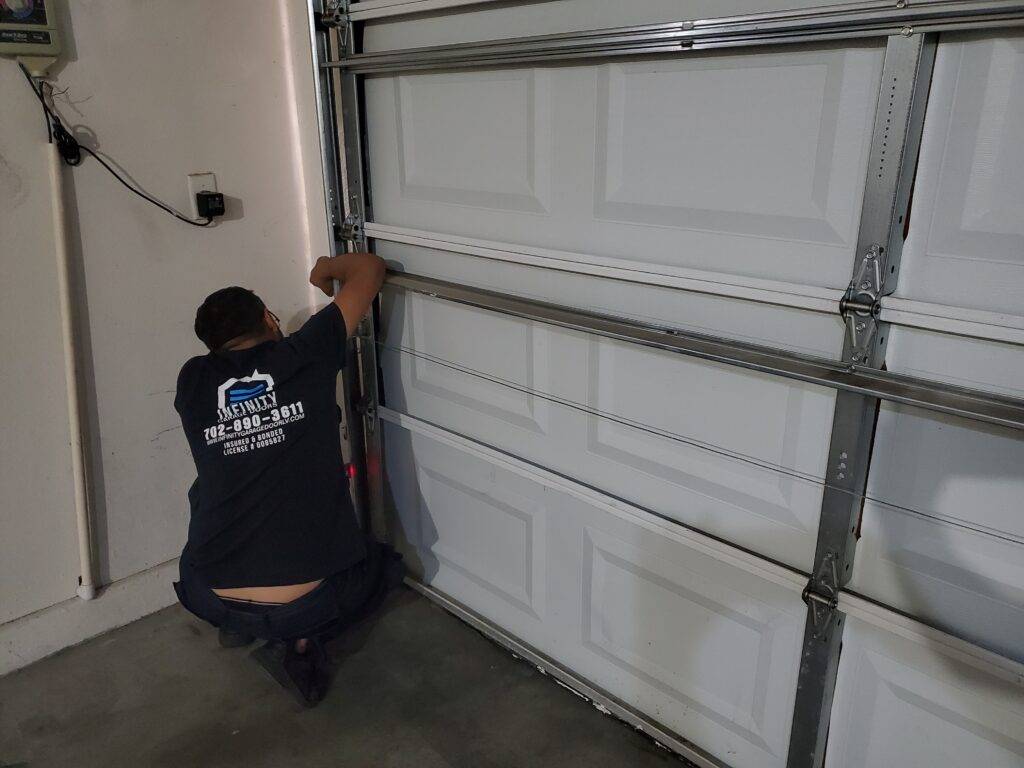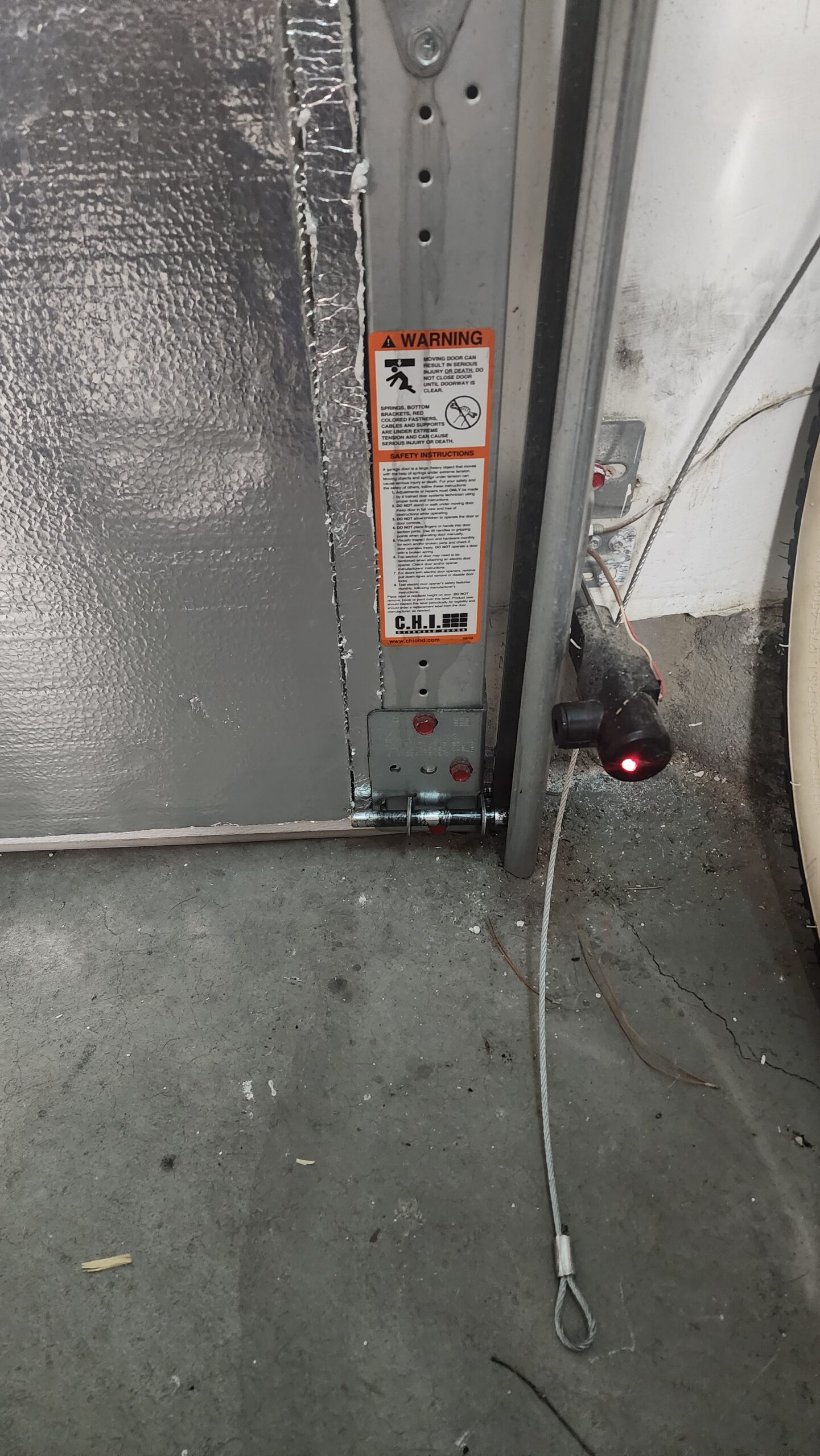Did you know that every year in the United States, there are over 30,000 injuries caused by garage door accidents? These accidents can occur due to various reasons, including malfunctioning garage door systems. That’s why it’s crucial to have garage door sensors installed to ensure the safety and convenience of your home. In this article, I will explain why garage door sensors are essential, provide a step-by-step guide on how to install them, and offer troubleshooting tips to keep them in optimal working condition. Let’s dive in!
Key Takeaways:
- Garage door accidents cause over 30,000 injuries annually in the United States.
- Garage door sensors are crucial for ensuring the safety and convenience of your home.
- This article will provide a step-by-step guide on how to install garage door sensors.
- Troubleshooting tips will be offered to help you maintain the optimal working condition of your garage door sensors.
- Infinity Garage Door is your trusted partner for expert advice and professional service.
The Crucial Role of Garage Door Sensors
Garage door sensors play a crucial role in ensuring the safety and security of your home. By detecting obstacles in the path of the garage door, sensors prevent accidents and damage to property or vehicles. They are designed to detect the presence of people, pets, or objects and instantly reverse the direction of the garage door to avoid collisions. This feature is particularly important for households with children or pets, as it provides an extra layer of protection against accidents. Understanding the essential role of garage door sensors is key to appreciating their importance and ensuring their proper functioning.
Understanding the Functionality of Garage Door Sensors
In this section, let’s dive deeper into the functionality of garage door sensors and explore their key features. By understanding how garage door sensors work, homeowners can appreciate their importance for ensuring safety and security.
What Are Garage Door Sensors?
Garage door sensors are small electronic devices designed to detect potential obstacles or obstructions in the path of a closing garage door. They play a critical role in preventing accidents and damage by signaling the garage door opener to stop or reverse its movement when an object is detected.
How Infrared Technology Keeps Your Home Safe
The functionality of garage door sensors relies on infrared technology, which uses invisible beams to detect obstructions. These sensors consist of two parts: a sender and a receiver. The sender emits an infrared beam towards the receiver, creating an invisible barrier. When an object interrupts the beam, the receiver detects the interruption and sends a signal to the garage door opener, prompting it to stop or reverse.
Infrared technology is particularly effective because it can detect even the smallest objects, ensuring the safety of people, pets, and property. It provides an added layer of protection, especially for households with children or pets, by preventing the garage door from closing on them.
The Evolution from Mechanical to Photoelectric Safety Sensors
Garage door sensors have evolved over the years, transitioning from mechanical sensors to more advanced photoelectric safety sensors. Initially, mechanical sensors relied on physical contact to activate safety measures. When an object made contact with the sensor, it triggered the garage door opener to stop or reverse. While mechanical sensors were effective, they had limitations and were less reliable.
However, with the introduction of photoelectric safety sensors, the safety and reliability of garage door systems significantly improved. Photoelectric sensors use infrared technology to detect obstructions without the need for physical contact. This technology revolutionized the functionality of garage door sensors, making them more accurate, responsive, and secure.
By embracing photoelectric safety sensors, homeowners can benefit from enhanced safety and peace of mind, knowing that their garage doors are effectively protected against accidents and damage.
Garage door sensors

Garage door sensors are a key component of automatic garage door systems. They are typically installed near the bottom of the garage door tracks on either side. These sensors detect the presence of obstacles and send signals to the garage door opener to prevent accidents and ensure safe operation. Garage door sensors have become a standard safety requirement since 1993, making them an essential feature of modern garage doors. Whether you are installing new sensors or troubleshooting existing ones, understanding the function and importance of garage door sensors is crucial.
Step-by-Step Guide to Garage Door Sensor Installation
In this section, I will provide you with a comprehensive step-by-step guide to help you successfully install your garage door sensors. It’s important to follow this guide carefully to ensure optimal functionality and safety.
Tools and Materials Needed for Installation
Before getting started, make sure you have the following tools and materials:
- Garage door sensors (typically provided with your garage door opener)
- Tape measure
- Pencil or marker
- Drill with appropriate drill bits
- Screwdriver or wrench
- Level
- Wire stripper (if necessary)
Mounting and Aligning Your Sensors Correctly
Once you have gathered all the necessary tools and materials, it’s time to mount and align your garage door sensors. Follow these steps:
- Locate the ideal positions for your sensors. Typically, they should be mounted on the side tracks, about 6 inches above the ground. Use a tape measure and level to ensure accuracy.
- Mark the mounting holes for each sensor with a pencil or marker.
- Use a drill to create pilot holes for the screws.
- Securely attach the sensors to the mounting holes using the provided screws or other appropriate fasteners.
- Ensure that the sensors are level and aligned properly. Use a level to check the alignment and make any necessary adjustments.
Connecting the Sensors to the Garage Door Opener
After mounting and aligning your sensors, the next step is to connect them to the garage door opener. Here’s how:
- Locate the sensor wires coming from the sensors and the corresponding wires on the garage door opener.
- Strip the ends of the sensor wires to expose the bare copper.
- Connect the sensor wires to the corresponding terminals on the garage door opener. Ensure a secure connection.
- If your sensors require additional wiring, follow the manufacturer’s instructions for proper installation.
Following these steps will complete the installation of your garage door sensors. It’s important to conduct a test to ensure that the sensors are working correctly and detecting obstacles.
Refer to the manufacturer’s instructions for specific testing procedures and troubleshooting tips. If you encounter any issues or need further assistance, don’t hesitate to contact a professional for help.
Garage Door Sensor Troubleshooting: Common Issues
Troubleshooting is an essential skill for maintaining the proper functioning of garage door sensors. In this section, I will highlight common issues that homeowners may encounter with their sensors and provide troubleshooting tips to resolve these problems. By understanding the potential problems and their solutions, homeowners can save time and money by resolving minor issues themselves.
Common Issues
Here are some of the most common issues that homeowners may face with their garage door sensors:
- Misaligned sensors: When the sensors are not properly aligned, the garage door may not function correctly and may reverse without any obstacles.
- Dirty lenses: Dust, dirt, or debris on the lenses can interfere with the sensor’s ability to detect obstacles, leading to malfunctioning.
- Wiring problems: Damaged or loose wires can disrupt the communication between the sensors and the garage door opener, causing issues with the sensor’s functionality.
- Interference from other devices: Certain devices or electrical equipment near the sensors can create electromagnetic interference, affecting the sensor’s performance.
- Faulty sensors: In some cases, sensors may become faulty, requiring replacement for optimal garage door operation.
By identifying these common issues, homeowners can proceed with troubleshooting to resolve them effectively.
Troubleshooting Tips
Here are some troubleshooting tips to address the common issues with garage door sensors:
- Sensor alignment: Check the alignment of the sensors to ensure they are facing each other and aligned correctly. Adjust them if necessary to ensure a clear line of sight between the sensors.
- Clean the lenses: Gently clean the lenses of the sensors using a soft cloth or tissue to remove any dust, dirt, or debris that may be obstructing the sensor’s ability to detect obstacles.
- Inspect the wiring: Check the wiring connections of the sensors and ensure they are securely connected. If any wires appear damaged or loose, consult a professional for repairs or replacements.
- Avoid interference: Identify any devices or equipment that may be causing electromagnetic interference and try to minimize their proximity to the sensors. Additionally, ensure that the sensors are not near sources of direct sunlight, as it can affect their performance.
- Consider sensor replacement: If all troubleshooting steps have been followed and the issue persists, it may be necessary to replace the sensors to restore proper functionality. Consult a professional for assistance and guidance.
By following these troubleshooting tips, homeowners can address common issues with their garage door sensors and ensure the proper functioning of their garage door systems.
Remember, it’s important to prioritize safety when troubleshooting garage door sensors. If unsure or uncomfortable performing any troubleshooting steps, it’s always best to consult a professional technician for assistance. They have the expertise to diagnose and resolve complex issues while ensuring the safety and functionality of your garage door sensors.
How to Align and Adjust Your Garage Door Sensors

Proper alignment of garage door sensors is essential for their optimal functioning. In this section, I will guide you through diagnosing and resolving alignment problems that can cause sensors to malfunction. By following these step-by-step instructions, you will learn how to adjust the sensor positions to ensure accurate detection of obstacles and seamless operation. Fine-tuning sensor positions is crucial for maintaining optimal safety and preventing accidents or damage. Let’s get started!
Diagnosing Alignment Problems
Before you can align your garage door sensors, it’s important to diagnose any alignment issues they may have. Here are some common signs of alignment problems:
- The garage door does not close completely or reverses immediately after closing.
- The garage door stops halfway through opening or closing.
- The sensor lights are not illuminated, or they blink rapidly.
If you notice any of these issues, it’s likely that your sensors are misaligned. Let’s move on to adjusting their positions to ensure optimal functionality.
Fine-tuning Sensor Positions for Optimal Safety
To align your garage door sensors, follow these steps:
- Check the sensor alignment: Start by visually inspecting the sensors and making sure they are facing each other directly. They should be parallel to each other and at the same height.
- Loosen the mounting brackets: Use a screwdriver or wrench to loosen the mounting brackets that secure the sensors in place.
- Adjust the sensor positions: Gently move the sensors until they are properly aligned. This may require some trial and error, so be patient. Make sure the sensor lights are illuminated and steady once aligned.
- Tighten the mounting brackets: Once the sensors are aligned, tighten the mounting brackets to secure them in their new positions.
- Test the sensor alignment: Activate your garage door opener and observe the sensor lights. If they remain illuminated and the garage door operates smoothly, the alignment is successful!
Following these steps will help you align and adjust your garage door sensors effectively, ensuring optimal safety and functionality. Now you’re ready to enjoy the convenience and peace of mind provided by properly aligned sensors.
Tackling Environmental Challenges for Garage Door Sensors
Garage door sensors play a vital role in ensuring the safety and functionality of your garage door system. However, they can face various environmental challenges that may impact their performance. To ensure the reliable operation of your garage door sensors, it is important to address these environmental factors. Let’s explore some common environmental challenges and discover practical solutions to tackle them.
One of the significant environmental challenges that garage door sensors can face is sunlight. Direct sunlight can interfere with the infrared technology used by sensors, leading to unreliable detection of obstacles. To mitigate this issue, consider using shades or covers to block out excessive sunlight and create a more stable sensor environment.
Another environmental challenge to be aware of is moisture. Exposure to moisture, such as rain or high humidity, can affect the sensors’ functionality. Moisture can cause corrosion and damage the internal components of the sensors. To protect your garage door sensors, ensure that the sensor housing and wiring connections are sealed properly. Consider using waterproof sealants or covers to shield the sensors from moisture.
Extreme temperatures can also pose a challenge for garage door sensors. Cold temperatures can cause the sensor components to contract, potentially affecting their alignment and performance. On the other hand, extreme heat can lead to expansion and warping of the sensor housing, impacting the overall functionality. To mitigate these temperature-related challenges, ensure that the sensors are properly insulated and protected from extreme temperature fluctuations.
By addressing these environmental challenges and implementing appropriate solutions, homeowners can maintain the reliable operation of their garage door sensors. Taking proactive measures to safeguard the sensors from sunlight, moisture, and extreme temperatures will help ensure the safety and convenience of your garage door system.
Protocols for Sensors
To maintain the functionality of your garage door sensors, it is important to regularly clean them to remove any dirt, dust, or debris that can accumulate and obstruct their operation. Here are some cleaning protocols to follow:
- Gently wipe the sensor lenses using a soft, lint-free cloth to remove any dirt or smudges.
- Do not use harsh chemicals, abrasive cleaners, or solvents as they can damage the sensors.
- Ensure that the lenses are free from any obstructions or coverings that may interfere with their ability to detect obstacles.
- Periodically inspect the sensor wires for any signs of damage or wear. If you notice any issues, contact a professional for repair or replacement.
Periodic Testing for Reliable Operation
In addition to regular cleaning, periodic testing of your garage door sensors is crucial to ensure their reliable operation. Here are some steps to follow:
- Stand clear of the garage door’s path and activate the door to close.
- Using an object such as a broomstick, gently wave it in front of one of the sensors to interrupt the beam.
- If the sensors are working correctly, the garage door should immediately stop and reverse its movement.
- Repeat the test with the other sensor to ensure both are functioning properly.
- If the door does not reverse or if there are any issues with the sensor’s response, it is recommended to contact a professional for inspection and repair.
By following these maintenance tips and regularly testing your garage door sensors, you can ensure the longevity and reliable operation of your garage door system, providing enhanced safety and convenience for your home.
When to Call Infinity Garage Door for Sensor Repair or Replacement
While troubleshooting and maintenance can resolve many issues with garage door sensors, there are times when professional assistance is necessary. At Infinity Garage Door, we are experts in sensor repair and replacement, providing reliable solutions for all your garage door sensor needs.
When you encounter complex wiring issues or extensive sensor damage, it’s best to call our skilled technicians who can diagnose the problem accurately and offer effective solutions. We have the knowledge and expertise to handle any sensor-related issue, ensuring the optimal functioning of your garage door system.
By reaching out to Infinity Garage Door, you can avoid further damage and ensure the longevity of your garage door sensors. We are committed to delivering exceptional service and customer satisfaction, providing prompt and reliable repairs or replacements when needed.
Trust the experts at Infinity Garage Door to handle all your sensor repair or replacement needs. Call us today at 702-890-3611 for professional assistance and peace of mind.
Exploring the Top-Rated Garage Door Sensors to Buy
For homeowners in search of new garage door sensors, it’s important to choose a top-rated option that combines quality and performance. In this section, we will explore some of the best garage door sensors available in the market, allowing you to make an informed decision based on your specific needs and preferences.
Features to Look For in a Quality Sensor
When selecting a garage door sensor, it’s crucial to consider the features that contribute to its quality and reliability. Here are some key aspects to look for:
- Infrared Technology: Opt for sensors that utilize infrared technology for accurate and efficient detection of obstacles. This ensures that your garage door will promptly respond to potential hazards.
- Easy Installation: Choose sensors that come with clear installation instructions and are designed for hassle-free setup. This will help you save time and ensure a proper installation.
- Reliability: Look for sensors from reputable brands that have a proven track record of reliability and durability. This ensures that your garage door sensors will function optimally for an extended period of time.
By considering these features, you can choose a high-quality garage door sensor that meets your safety needs and offers long-lasting performance.
Conclusion
In conclusion, garage door sensors play a crucial role in ensuring the safety and convenience of your automatic garage door system. Their ability to detect obstacles and instantly reverse the door’s direction prevents accidents and damage to property or vehicles. Proper installation and alignment are key to their optimal functionality, allowing them to accurately detect and respond to potential obstructions. Regular maintenance, including cleaning and periodic testing, is essential to ensure the longevity of your garage door sensors.
By following the guidelines and recommendations provided in this article, homeowners can enjoy the benefits of reliable and secure garage door sensors. Remember, Infinity Garage Door is always ready to assist you with your garage door sensor needs. Whether you require professional installation, troubleshooting, or repair services, their team of experts is committed to providing the highest level of advice and service.
Ensure the safety and functionality of your garage door system by prioritizing the importance of garage door sensors. Don’t hesitate to reach out to Infinity Garage Door at any time with all your sensor inquiries or requirements. Trust their expertise and experience to help you keep your garage door sensors in optimal working condition, providing you with peace of mind and convenience every day.

FAQ
What is the purpose of garage door sensors?
Garage door sensors play a crucial role in ensuring the safety and security of your home by detecting obstacles and preventing accidents or damage.
How do garage door sensors work?
Garage door sensors use infrared technology to create an invisible beam. When an object obstructs this beam, the sensors send a signal to the garage door opener, prompting it to stop or reverse its movement.
What are photoelectric safety sensors?
Photoelectric safety sensors are modern garage door sensors that use infrared technology for enhanced safety and reliability.
Where are garage door sensors typically installed?
Garage door sensors are typically installed near the bottom of the garage door tracks on either side.
How do I install garage door sensors?
To install garage door sensors, you will need to mount and align them correctly and then connect them to the garage door opener. Follow our step-by-step guide for detailed instructions.
What are some common issues with garage door sensors?
Common issues with garage door sensors include misalignment, dirty lenses, and damaged wires. These can be resolved through troubleshooting techniques.
How can I align and adjust my garage door sensors?
You can align and adjust your garage door sensors by diagnosing alignment problems and fine-tuning sensor positions for optimal safety. Follow our guide for detailed instructions.
How do I tackle environmental challenges that affect garage door sensors?
Common environmental challenges for garage door sensors include sunlight, moisture, and extreme temperatures. Our guide provides practical solutions to address these challenges.
What maintenance tips can I follow to ensure the longevity of my garage door sensors?
Cleaning the sensors regularly and performing periodic testing are crucial for maintaining the optimal functioning of garage door sensors. Follow our maintenance tips for detailed guidelines.
When should I call for professional help with my garage door sensors?
You should call for professional help when you encounter complex wiring issues or extensive sensor damage that requires repair or replacement. Contact Infinity Garage Door for expert assistance.
What are the top-rated garage door sensors to buy?
When buying garage door sensors, look for features such as infrared technology, easy installation, and reliability. Compare leading brands and models to make an informed choice.
Read more: Garage Door Repair Las Vegas

